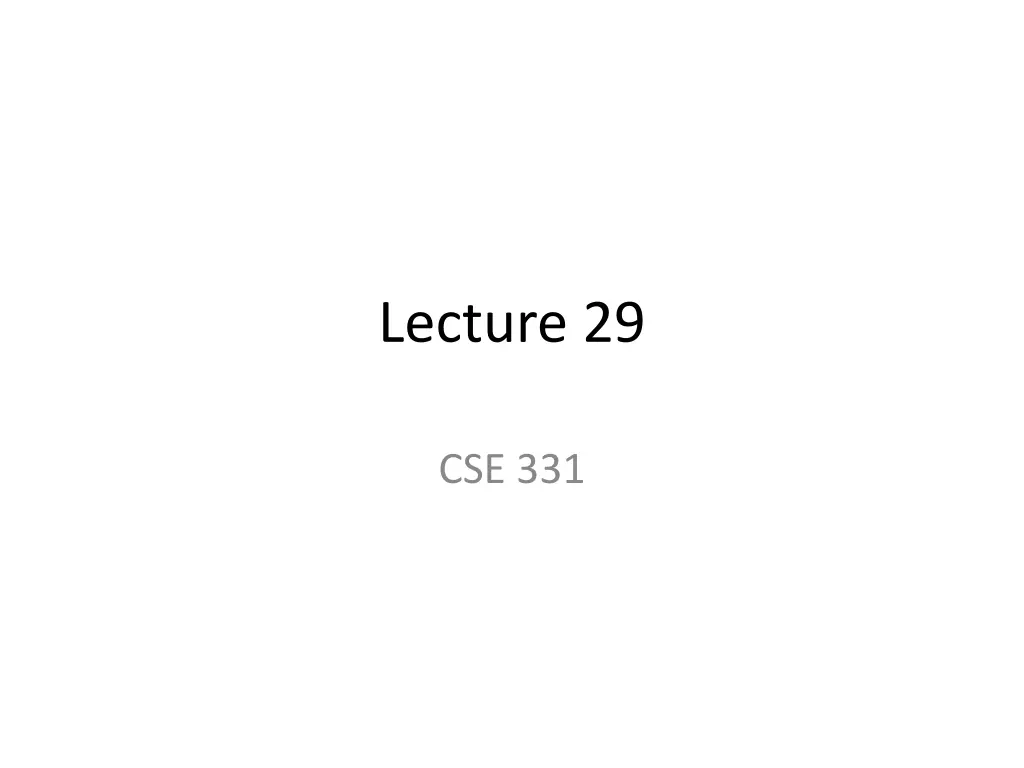
Optimal Problem-Solving Techniques in CSE 331
Explore the high-level view of problem statements, algorithm implementation, data structures, and correctness with runtime analysis in CSE 331. Discover the effectiveness of Greedy Algorithms, Divide and Conquer, Dynamic Programming, and more in reducing computational complexity and achieving optimal solutions.
Download Presentation

Please find below an Image/Link to download the presentation.
The content on the website is provided AS IS for your information and personal use only. It may not be sold, licensed, or shared on other websites without obtaining consent from the author. If you encounter any issues during the download, it is possible that the publisher has removed the file from their server.
You are allowed to download the files provided on this website for personal or commercial use, subject to the condition that they are used lawfully. All files are the property of their respective owners.
The content on the website is provided AS IS for your information and personal use only. It may not be sold, licensed, or shared on other websites without obtaining consent from the author.
E N D
Presentation Transcript
Lecture 29 CSE 331
High level view of CSE 331 Problem Statement Problem Definition Three general techniques Algorithm Implementation Data Structures Analysis Correctness+Runtime Analysis
Greedy Algorithms Natural algorithms Reduced exponential running time to polynomial
Divide and Conquer Recursive algorithmic paradigm Reduced large polynomial time to smaller polynomial time
A new algorithmic technique Dynamic Programming
Dynamic programming vs. Divide & Conquer Both design recursive algorithms Dynamic programming is smarter about solving recursive sub-problems
End of Semester blues Can only do one thing at any day: what is the optimal schedule to obtain maximum value? (10) Write up a term paper Party! (2) (5) (3) Exam study 331 HW Project (30) Saturday Sunday Monday Tuesday Wednesday
Previous Greedy algorithm Order by end time and pick jobs greedily Greedy value = 5+2+3= 10 (10) Write up a term paper OPT = 30 Party! (2) Exam study (5) 331 HW (3) Project (30) Saturday Sunday Monday Tuesday Wednesday
Todays agenda Formal definition of the problem Start designing a recursive algorithm for the problem
Weighted Interval Scheduling Input: n jobs/intervals. Interval i is triple (si, fi, vi) start time value finish time v3 = 2 v4 = 3 v2 = 4 v1 = 30 2 3 1 0
Previous Greedy Algorithm R = original set of jobs While R is not empty Choose i in R where fi is the smallest Add i to S Remove all requests that conflict with i from R Return S* = S v3 = 2 v4 = 3 v2 = 4 v1 = 30 2 3 1 0
Perhaps be greedy differently? R = original set of jobs While R is not empty Choose i in R where vi/(fi si) is the largest Add i to S Remove all requests that conflict with i from R Return S* = S v3 = 2 v4 = 3 v2 = 4 v1 = 30 2 3 1 0
Can this work? R = original set of jobs While R is not empty Choose i in R where vi/(fi si) is the largest Add i to S Remove all requests that conflict with i from R Return S* = S v3 = 2 v4 = 3 v2 = 6 v1 = 12 2 3 1 0
Avoiding the greedy rabbit hole Provably IMPOSSIBLE for a large class of greedy algos https://www.writerightwords.com/down-the-rabbit-hole/ There are no known greedy algorithm to solve this problem
Perhaps a divide & conquer algo? Divide the problem in 2 or more many EQUAL SIZED INDEPENDENT problems Recursively solve the sub-problems Patchup the SOLUTIONS to the sub-problems
Perhaps a divide & conquer algo? RecurWeightedInt([n]) if n = 1 return the only interval L = first n/2 intervals R = last n/2 intervals Would this general scheme work? SL = RecurWeightedInt(L) SR = RecurWeightedInt(R) PatchUp(SL, SR) Divide the problem in 2 or more many EQUAL SIZED INDEPENDENT problems
Sub-problems NOT independent! v6 = 20 v3 = 10 v2 = 2 v4 = 4 v1 = 1 v5 = 5 2 3 0 1
Perhaps patchup can help? Patchup the SOLUTIONS to the sub-problems v6 = 20 v3 = 10 v2 = 2 v1 = 1 2 3 0 1
Sometimes patchup NOT needed! v6 = 0 v3 = 10 v2 = 2 v4 = 4 v1 = 1 v5 = 5 2 3 0 1
Check for two cases? 6 is in the optimal solution v6 = 20 v3 = 10 v2 = 2 v4 = 4 v1 = 1 v5 = 5 2 3 1 0 6 is NOT in the optimal solution v6 = 0 v3 = 10 v2 = 2 v4 = 4 v1 = 1 v5 = 5 2 3 1 0
Check if v6 is the largest value? 6 is in the optimal solution v6 = 20 v3 = 10 v2 = 2 v4 = 4 v1 = 1 v5 = 5 Cannot decide this greedily. Need to 2 3 1 0 6 is NOT in the optimal solution have a global view! v6 = 0 v6 = 20 v3 = 10 v2 = 2 v4= 14 v1 = 1 v5 =15 2 3 1 0
Check out both options! v6 = 20 v3 = 10 v2 = 2 v1 = 1 v4 = 4 v5 = 5 2 3 1 0 Case 1: 6 is in the optimal solution
6 is not in optimal solution v6 = 20 v3 = 10 v2 = 2 v4= 14 v1 = 1 v5 =15 2 3 1 0
So what sub-problems? Divide the problem in 2 or more many EQUAL SIZED INDEPENDENT problems Sub problem 3 Original problem Sub-problem 2 Sub-problem 5 Sub problem 1 Sub problem 4
